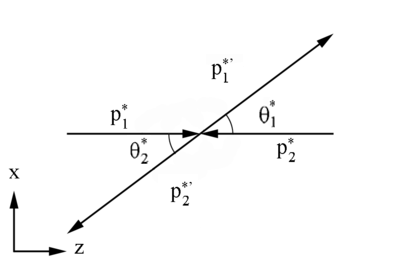Difference between revisions of "U-Channel"
Jump to navigation
Jump to search
(Created page with " =u-Channel=") |
|||
| (6 intermediate revisions by the same user not shown) | |||
| Line 1: | Line 1: | ||
| + | <center><math>\underline{\textbf{Navigation}}</math> | ||
| + | |||
| + | [[T-Channel|<math>\vartriangleleft </math>]] | ||
| + | [[VanWasshenova_Thesis#Moller_Scattering|<math>\triangle </math>]] | ||
| + | [[Limits_based_on_Mandelstam_Variables|<math>\vartriangleright </math>]] | ||
| + | |||
| + | </center> | ||
| + | |||
=u-Channel= | =u-Channel= | ||
| + | The u quantity is does not have a clear cut interpretation like the s and t channels | ||
| + | |||
| + | <center><math>u \equiv \left({\mathbf P_1^*}- {\mathbf P_2^{'*}}\right)^2=\left({\mathbf P_2^*}- {\mathbf P_1^{'*}}\right)^2</math></center> | ||
| + | |||
| + | <center>[[File:400px-CMcopy.png]]</center> | ||
| + | |||
| + | |||
| + | |||
| + | <center><math>u \equiv\left({\mathbf P_1^*}- {\mathbf P_2^{'*}}\right)^2</math></center> | ||
| + | |||
| + | |||
| + | <center><math>u \equiv \mathbf P_1^{*2}-2 \mathbf P_1^* \mathbf P_2^{'*}+ \mathbf P_2^{'*2}</math></center> | ||
| + | |||
| + | |||
| + | <center><math>u \equiv 2m_1^2-2E_1^*E_2^{'*}+2 \vec p \ _1^* \vec p \ _2^{'*}</math></center> | ||
| + | |||
| + | |||
| + | In the center of mass frame of reference, | ||
| + | |||
| + | <center><math> E^* \equiv E_1^*=E_1^{'*} = E_2^*=E_2^{'*} = E_1^*=E_2^*</math></center> | ||
| + | |||
| + | |||
| + | and | ||
| + | |||
| + | |||
| + | <center><math>|p^*| \equiv | \vec p \ _1^*|=| \vec p \ _1^{'*}| =| \vec p \ _2^*|=| \vec p \ _2^{'*}|</math></center> | ||
| + | |||
| + | |||
| + | and <math>\theta_1=-\theta_2</math> is the angle between <math>\vec p \ _1^* </math> and <math> \vec p \ _2^{'*}</math> | ||
| + | |||
| + | |||
| + | |||
| + | <center><math>u \equiv 2m_1^*-2E_1^{*2}-2 |p |^{*2}cos\ \theta</math></center> | ||
| + | |||
| + | |||
| + | Using the relativistic term for Energy | ||
| + | |||
| + | |||
| + | <center><math>E^2=\vec p \ ^2+m^2</math></center> | ||
| + | |||
| + | |||
| + | |||
| + | <center><math>u \equiv -2 p \ ^{*2}(1+cos\ \theta)</math></center> | ||
| + | |||
| + | |||
| + | ---- | ||
| + | |||
| + | |||
| + | |||
| + | <center><math>\underline{\textbf{Navigation}}</math> | ||
| + | |||
| + | [[T-Channel|<math>\vartriangleleft </math>]] | ||
| + | [[VanWasshenova_Thesis#Moller_Scattering|<math>\triangle </math>]] | ||
| + | [[Limits_based_on_Mandelstam_Variables|<math>\vartriangleright </math>]] | ||
| + | |||
| + | </center> | ||
